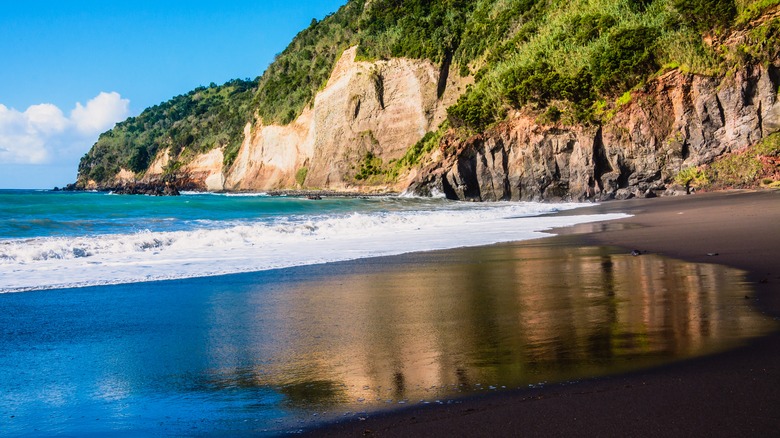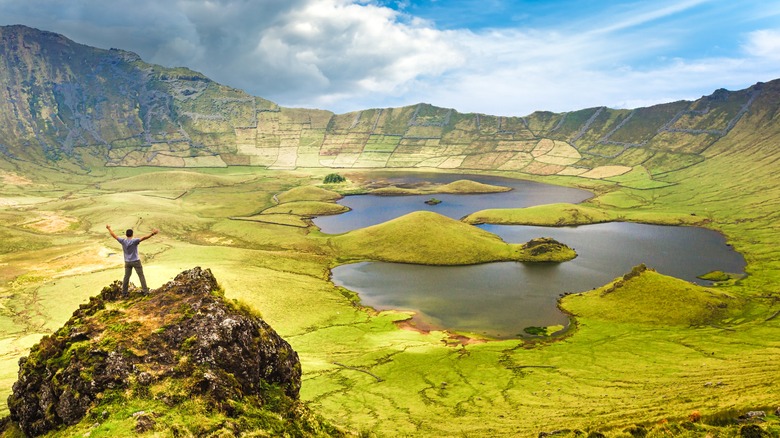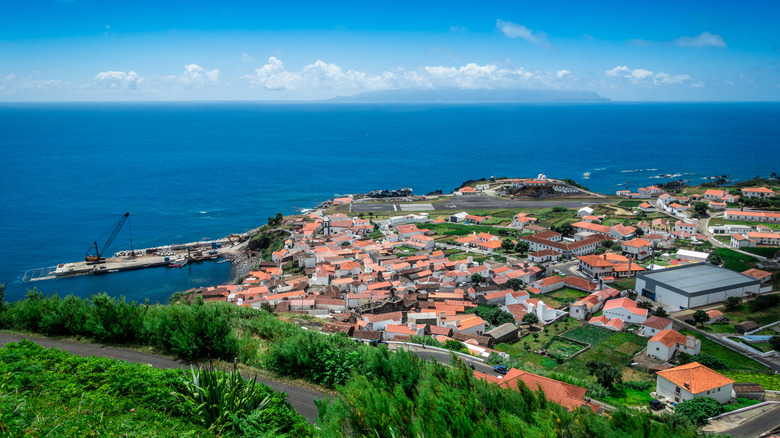Relax Beachside At This Lesser-Known Unique European Island
A few hours off the coast of mainland Europe, a volcanic archipelago called the Azores is affectionately known as the "Hawaii of Europe." Settled by the Portuguese in the 1400s, each of the nine islands has developed its own distinct community and personality. For travelers searching for European beaches without all the hustle and bustle of the mainland, these gems in the middle of the Atlantic offer peace and quiet, warm hospitality, and epic views to end all views. The westernmost island of Corvo is no exception.
With just 10 square miles of scenery, Corvo is the smallest and most remote island of the bunch. When you arrive on the southern end via the port or airstrip, you'll find Vila do Corvo, a charming town with 400 residents and the only inhabited area. As you wander around the canadas (narrow streets), you'll find dark cottages made of basalt and windmills that look like they were plucked straight from the Portuguese countryside — a small reminder that you are, technically, exploring another side of Portugal.
Oh, and don't be fooled by the wooden locks that adorn the homes. They're purely decorative, as the locals don't bother to lock the doors. In fact, you'll likely be welcomed as part of the Corvo family, as it's the kind of place where everyone knows everyone else. The residents didn't get onto the electric grid until 1963, so you can only imagine how tight-knit the community is.
Things to do in Corvo
Start your time in this remote paradise with a trip to the Ecomuseu do Corvo, a museum where you can learn about the history of the residents and the local landscape. A natural next stop would be the Centro de Intepretação de Aves Selvagens do Corvo for a fascinating glimpse into the many migratory bird species that call this island home. The island's main church, the Igreja de Nossa Senhora dos Milagres, is another notable point for its 18th-century architecture.
When you're ready to stretch your legs a bit, head to the caldeirão de corvo (the caldera) sitting in the northwest corner of the island. The crater serves as a stunning reminder of the now dormant volcano that formed this gorgeous scenery, paving the way for the island to be named a UNESCO World Biosphere Reserve. Follow the PR2 COR trail around the interior to get an up-close view of the lakes in the center and say hello to a few cows. Back on the coast near the village, take the rest of the day off and lounge on a beach known for its colored sand called Praia da Areia, the main swimming area warm enough for a dip or a dive.
Before you visit Corvo
To get to Corvo Island, you'll need to book a ferry from Flores with Atlantico Lines or take an inter-island flight with Sata Azores Airlines. If you only plan to visit for the day, a guided boat tour will give you the best chance to spot dolphins and whales along the way. Once you've arrived, there are no buses, so you'll need to rent a bike, scooter, or car to get around. You can also take a taxi to the top of the caldera if you'd rather skip the two-and-a-half-hour hike.
Once you've worked up an appetite, there are two main restaurants in town. The O Caldeirao is a solid place for seafood and vegetables with a rotating menu that staff posts on its Facebook page. The other option is BBC Cafe and Lounge, which offers comfort fare like steaks and burgers. As you stroll around the village, don't forget to tuck into a few local favorites, like erva do calhau (seaweed grass tart), couves da barça (kale and pork), or homemade cheese cured for 60 days.
The best time to visit Corvo is mid-August when the weather is warm and the island's main festival, the Festas da Nossa Senhora dos Milagres, is in full swing. With lively music, food, drinks, and a fireworks display, you'll develop a whole new appreciation for this small rock and its people in the heart of the ocean. Looking for more under-the-radar European destinations? Next, enjoy the white sand beaches at this lesser-known German island.


